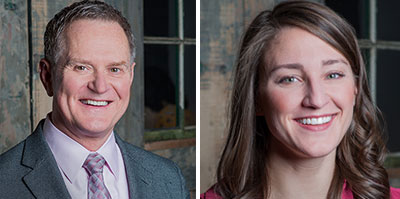EYE CARE CENTER of Colorado Springs, CO, has a large specialty contact lens practice that owes its success in part to the referrals it receives from ODs and MDs in Colorado Springs, Denver, Pueblo and as far away as California. You don’t maintain a referral-driven practice without top-level service, and with so much on the line, sometimes it pays to codify what’s expected of staff. But no one responds to a laundry list of rules. “We have found we have to re-educate ourselves and any new team members we hire,” says co-owner Sara Whitney, OD, and this realization recently led the practice to develop its own “office culture blueprint.”
THE IDEA
Translating a vague desire to get the best out of your team into a set of tangible principles is harder than it sounds. “We made a feeble attempt to create a culture statement a few years ago,” recalls Whitney, “and we never finished it because we didn’t really know how to implement it.” Practice founder and co-owner Dr. Reed Bro eventually came across the concept of “above the line behavior,” an approach based on personal responsibility. Whitney says the beauty of this concept is that it encourages “behaviors that create a positive event for the next person in the chain.” The goal is to “resist the temptation to blame…to complain for the sake of complaining, or become defensive.”

Dr. Reed Bro and Dr. Sara Whitney
THE EXECUTION
Whitney, Bro and office manager Mindi Andrade developed what would become the office’s cultural blueprint over several months. It takes its starting point from a few core beliefs. These are matched with a set of encouraged behaviors and desired outcomes. Your core beliefs, Whitney says, “are the reasons you decided to start practicing optometry or open a business.”
Advertisement
Once these basic elements were finalized, the managers initiated a transitional phase in which they used the vocabulary that forms the core of the blueprint in day-to-day interactions with one another and with staff. “We did not present the blueprint to the team until we were comfortable that we were able to personally apply the core beliefs to any situation,” Whitney says. They launched it at the beginning of January, when people are making resolutions and personal improvements. “We printed up the culture matrix on a card for each member of the team.”
Whitney says you can tell right away which staff will be on board and who will resist. “We lost three team members around the time the blueprint was rolled out. It may have just been a personal decision for the employee, but it can cause you to momentarily doubt your decision to demand these behaviors.” It’s important to be strong and stick to your guns at this stage, she says. Remember that the key beliefs you identified as the basis for your blueprint are important. “They are the reason you get up in the morning and come to work,” she says. “Expectations … make some people uncomfortable. They will resist change, and you have to let them move on.”
THE REWARDS
Whitney says the blueprint has delivered its targeted outcomes: an enhanced sense of community, patient satisfaction, trust, loyalty, adherence to treatment plans, and referrals. But there are personal benefits too. “I think those who have embraced this new mindset will be able to see it spilling over into their personal lives.”
Ultimately, Eye Care Center of Colorado Springs’ aim with the blueprint was to cultivate behaviors that grow the business, and so far, that aim is being met. Says Whitney: “We have developed the mindset that being presented with a challenge is our opportunity to get ahead of the problem and to possibly even be someone’s hero.”
Do It Yourself: Develop an Office Culture
- DON’T RUSH IT. “Take time to define your beliefs over a period of weeks or months,” says Whitney.
- WALK THE WALK. “Live out behaviors that support your beliefs,” Whitney advises. “You are the biggest example of your practice culture.”
- TWO-WAY STREET. An office culture doesn’t have to be static: Survey your team periodically and ask for feedback.
- COMMUNICATE. If you don’t, a blueprint is just a list tacked to a wall.
- STAY STRONG. A change like this might cost you an employee. But stay the course or it’s not worth the paper it’s written on.